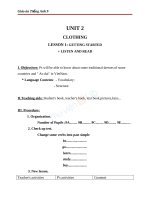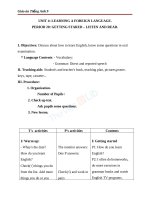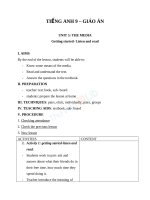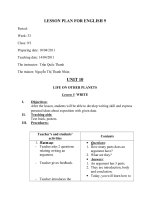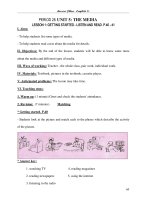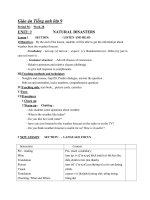giáo án tiếng anh 9 unit 10 - recycling
Bạn đang xem bản rút gọn của tài liệu. Xem và tải ngay bản đầy đủ của tài liệu tại đây (142.59 KB, 25 trang )
UNIT 10: RECYCLING
LESSON 1: - GETTING STARTED (PAGE 89)
- LISTEN AND READ 1, 2 (PAGE 90)
A. Aim: - By the end of the lesson, Ss will be able to do something to protect the
environment and save natural resources.
B. Methods: Communicative approach
C. Teaching aids: Teacher: textbook, poster, pictures
Students: textbook, notebook, pens, rulers.
D. Procedure:
I. Class management: 1 minute
II. Revision: (5 minutes) WARM-UP
III. New lesson:
1. Setting the scene: Included in the WARM-UP
2. Main activities:
Teacher’s and students’ activities On the board
- Collect the ideas from the students
- Ss think of ways to reduce the
amount of garbage.
- Students work in groups of 6 and
write their answers on the posters and
put the poster on the board after they
finish. The team having the most
satisfactory ideas is the winner.
WARM-UP
Reuse plastic bags.
* Expected answers:
Ways to reduce the
amount of garbage
- Give feedback.
- Present new words on the board.
- Have Ss copy
- Guide Ss to read them in chorus.
- Write the Jumbled words on the
board and divide Ss into 2 teams to
play the game.
- Set the scene: “A representative
from Friends of the Earth, Miss
- recycle old bottles, cans
- reuse bottles
- use paper to wrap food
- not buy goods that are overpackaged
-
PRE-READING
I. Vocabulary:
-
representative
(translation)
-
(to) protect
(explanation)
= to keep so/ s.t safe from danger.
-
(to) recycle
(explanation)
= to make old things be able to be used again
-
(to) reuse
(explanation)
= to use s.t again
- natural resources (picture)
coal, mines, oil, gold,
-
(to) contact
(explanation)
= to communicate with
-
instead of
(translation)
Blake, is talking to the students of
Quang Trung school. Friends of the
Earth shows people how to protect
the environment and save natural
resources”.
- Ask students to work in pairs to
decide if the statements are true or
false.
- Write the Ss' guesses on the board.
- Ask students to open their books,
listen to the tape while reading the
dialogue.
- Call on students to correct the false
statements.
-
(to) overpackage
(translation)
* Checking techniques: Jumbled words.
II. True/ False predictions:
1. Friends of the Earth is an organization to help
people make friends with each other.
2. Miss Blake asks the students to remember 3
things: reduce, reuse, and recycle.
3. Reduce means buying the products which are
over packed.
4. We cannot reuse things like envelopes glass,
plastic bottles, and old plastic bags.
5. Miss Blake says that we should use cloth bags
and shouldn't use plastic bags at all.
6. Recycling means not just throwing things
away but trying and finding another use for them.
WHILE-READING
Read the dialogue and check their prediction.
□ Correct the false statements.
Statements
Answers
Correction
1
2
3
F
T
F
protect the
environment and save
natural resources
not buying
we can reuse things
- Ask students to look at the questions
on page 90 and work in pairs
- Monitor and help students with their
work
- Call on some pairs to ask and
answer the questions
- Give feedback
- Write the topic on the board
- Ask students to express their
opinions/ideas on this topic
- Write the students’ ideas on the
board into a list
- Give feedback, correct and have
students copy
4
5
6
F
T
T
III. Comprehension questions
* Expected answers:
a. Reduce means not buying products which are
overpackaged.
b. We can reuse things like envelopes, glass,
plastic bottles and old plastic bags.
c. Recycle means not just throwing things away.
Try and find another use for them
d. We can look for information on recycling
things by having a contact with an organization
like Friends of the Earth, going to the local
library or asking your family and friends
e. Students’ answers
POST-READING
Discussion
How to protect our environment?
IV. Consolidation: (2 minutes)
- T asks students to summarize the main points of the dialogue.
V. Homework
- Write the questions and full answers in your exercise notebooks
- Prepare: speak and listen
PERIOD 62 Date: January 23
rd
,
2011
UNIT 10: RECYCLING
LESSON 2: - GETTING STARTED (PAGE 89)
- LISTEN AND READ 1, 2 (PAGE 90)
A. Aim: - To help students practice giving and responding to instructions and listening
for specific information about making compost
B. Methods: Communicative approach
C. Teaching aids: Teacher: textbook, poster, pictures
Students: textbook, notebook, pens, rulers.
D. Procedure:
I. Class management: 1 minute
II. Revision: (5 minutes) WARM-UP
III. New lesson:
1. Setting the scene: Included in the WARM-UP
2. Main activities:
Teacher’s and students’ activities
On the board
- Show the picture to the students
and ask them to observe it
carefully, let them look at the
WARM-UP
Kim’s game
* Possible answers: used paper, old newspapers,
books, cardboard boxes, bottles, glasses, jars,
plastic bags, food cans, drinking tins, vegetable
picture for about 20 seconds then
put it away.
- Divide the class into 2 teams
- Ask students to go to the board
and write as many words showing
things in the picture as possible.
- Tell the students the team with
the most right words is the winner
- Present new words on the board.
- Show the meaning of new words.
- Guide Ss to read them in chorus.
matter, clothes, shoes, schoolbags,
PRE-SPEAKING
I. Vocabulary:
-
Fertilizer
(explanation)
= Farmers often use this thing to make their plants
or trees grow well
(to) fertilize
- Compost (question)
= what do you call the fertilizer made from spoiled
food, leaves, vegetable matter
A compost heap
- Fabric (realia)
= clothes (what are these clothes made of?)
- Leather (question)
= Our shoes, sandals are often made of
- Metal (n) (picture)
- (to) belong to (translation)
- Check Ss' memory by technique
"Bingo"
- Tell students they are going to
listen to the words for items and
put them into the right groups
- Draw the table on the board and
ask students to copy it
- Model some words
- After listening, ask students to
work in pairs and give their
answers.
- Read the words again and correct
- Put the mapped dialogue chart on
the board
- Elicit the exchanges from the
students
- Have some pairs practice each
exchange before going on to
another exchange
- After finishing the dialogue, ask a
good pair to demonstrate the whole
dialogue
- grain (n) (picture)
- shade (n) (picture)
* Checking: Bingo
II. Dictation - list:
WHILE-SPEAKING
III. Mapped Dialogue:
Which group (do
clothes) belong to?
What can we do with
(those clothes)?
Is/ Are (fruit vegetable
matter)?
What will we do with
(it)?
Put (them) in
(fabric)
We can (recycle
them and make them
into paper or
shopping bags)
That’s right
We make (it into
Group Items
Paper
Used paper (old newspaper, books,
cardboard boxes).
Glass Bottles, glasses, jars.
Plastic Plastic bags, plastic bottles.
Metal Food cans, drinking tins.
Fabric
Leather
Vegetables
Clothes (cloth bags, material)
(shoes, sandals, schoolbags)
Fruit peels (vegetables, )
-
Open pairs:
Ask some pairs to
demonstrate the dialogue
- Closed pairs: Ask students to
work in pairs, replacing the
information (in brackets) with the
words in the dictation list.
- Tell students they are going to
listen to an expert who gives the
instructions to make compost
- Ask students to open their books
and read the multiple choice
questions on page 91
- Check if students understand the
questions
- Play the tape 2 or 3 times,
students listen and do the exercise
- Have students give their answers
and correct
compost and fertilize
our field)
POST-SPEAKING
IV. Multiple choice
Listen to four questions during the recording.
Check the correct answers.
* Expected answers:
a. A b. B c. A d. B
IV. Consolidation: (2 minutes)
- T asks students to summarize how to make compost
V. Homework
- Practice the dialogue with your partner, replacing the information
- Do the exercises in the workbook
PERIOD 63 Date: February 7
th
,
2011
UNIT 10: RECYCLING
LESSON 3: - READ (P.92)
A. Aim: - Reading for details about how things are recycled.
B. Methods: Communicative approach
C. Teaching aids: Teacher: textbook, poster, pictures
Students: textbook, notebook, pens, rulers.
D. Procedure:
I. Class management: 1 minute
II. Revision: (5 minutes) WARM-UP
III. New lesson:
1. Setting the scene: Included in the WARM-UP
2. Main activities:
Teacher’s and students’ activities On the board
- Put the word square chart on the
board
- Tell students the topic is about the
environment and there are 14 hidden
words
- Divide the glass into 4 groups
- Ask students to write their answers
on a piece of paper and hand in when
they finish
WARM-UP
A word square
E N V I R O N M E N T
N B C G A R B A G E R
V E D R D O P P U R E
E J U E Y I L A R S C
L U S E D P A P E R Y
O S T N O T S E D E C
- Tell students the group with the
most right words is the winner
- Elicit words from students.
- Guide Ss to read new words.
- Check Ss' memory by technique
"Rub out and Remember".
- Tell students they are going to read
a page in a newspaper giving some
P R O T E C T R U U L
E A B R C A I B C S E
R E C E E N C A E E K
D E E E F G H G I J L
environment, garbage, pure, used paper,
protect
envelope, dust, green tree, can, plastic, paper
bag, reduce, reuse, recycle.
PRE-READING
I. Vocabulary:
- a car tire [picture]
- a can [picture]
-
floor covering
[explanation]
= things used as a carpet in a house
- a deposit [translation]
-
(to) refill
[explanation]
= to fill st empty again
- (to) melt [antonym]
# (to) freeze
- dung (n) [picture]
- glassware (n) [picture]
* Checking vocabulary: Rub out and remember
recycling facts to protect the
environment
- Write the questions on the board
and ask students to guess what they
are going to read
- Write the students’ guesses on the
board
- Draw the grid on the board and
have students copy it
- Ask students to open their books
and read the text
- Ask students to work in pairs to
make a list of recycling facts
mentioned in the text
- Call on some students to write the
information in the grid on the board
- Ask students to work individually
to answer the questions on page 93
-Let students compare their answers
with their partners
- Give feedback
II. Open prediction:
What do people do with used things?
What can they make from them?
Car tires:
Milk bottles
Glass
Drink cans
Household and garden waste
WHILE-READING
III. Grids
*Expected answers:
Used things Recycling facts
Car tires
Milk bottles
Glass
Drink cans
Household and
garden waste
are recycled to make pipe
or floor coverings
are cleaned and refilled
(with milk)
is broken up, melted and
make into new glassware
are brought back for
recycling
is made into compost
IV. Comprehension questions
Expected answers:
- Open pairs: Ask some pairs to ask
and answer the questions
- Closed pairs: Ask students to work
in pairs to practice
- Ask Ss to look at the Grids and the
comprehension questions above to
retell the story.
a. They clean them and refill with milk
b. Glass is broken up, melted and made into new
glassware
c. The government made a law that there must be
a deposit on all drink cans. The deposit is
returned when people bring the cans back for
recycling
d. Compost is made from household and garden
waste
e. If I have a recycling story to share, I will call or
fax at 5 265 456
POST-READING
Retell the story
IV. Consolidation: (2 minutes)
- T asks students to state the main ideas of the passage
V. Homework
- Prepare Write
PERIOD 64 Date: February 9
th
,
2011
UNIT 10: RECYCLING
LESSON 4: - WRITE (P.93, 94)
A. Aim: - By the end of the lesson, Ss will be able to write a set of instructions, using the
sequencing
B. Methods: Communicative approach
C. Teaching aids: Teacher: textbook, poster, pictures
Students: textbook, notebook, pens, rulers.
D. Procedure:
I. Class management: 1 minute
II. Revision: (5 minutes) WARM-UP
III. New lesson:
1. Setting the scene: Included in the WARM-UP
2. Main activities:
Teacher’s and students’ activities On the board
- Call a student to the board and ask
him/her the vocabulary and questions.
WARM-UP
Revision:
Checking the last lesson
- Vocabulary: a car tire, a can, floor covering, a
deposit, refill, melt, freeze
, dung, glassware
- Read the passage and answer some questions:
1. What do people do with empty milk bottles?
2. What happens to the glass when it is sent to
the factories?
PRE-WRITING
I. Vocabulary:
- (to) soak: explanation (to put st in liquid for a
- Elicit words from students.
- Guide Ss to read new words.
* Set the scene: “You are going to
read a text about how to recycle used
paper.”
- Ask students to put the verbs on the
board randomly in a flow chart.
- Ask students to work in groups to
guess the order of the actions
- Call on about 2 groups to write their
answer on the board.
- Explain the process of recycling,
using mimes or Vietnamese and
correct
- Ask students to open their books,
read the text on page 93 and fill in the
verbs.
- Monitor and correct the exercise in
the text book.
- Give feedback
time so that it becomes completely wet)
- (to) mash: mime
- a wire mesh: translation
- a bucket: drawing
* Checking vocabulary: Rub out and remember
II. Ordering prediction
Soak dry pull out
mix press mash
1 2 3
4 5 6
Expected Answers:
1- soak 2- mash 3- mix
4- pull out 5- press 6- dry
WHILE-WRITING
III. Gap-filling
Expected Answers:
1. use 2. mix 3. place 4. press
5. wrap 6. wait 7. dry
IV. Recall:
First,
- Ask students to close their books
- Write the sequencing on the board
and have students to practice speaking
first.
- Call on students to say the sentences
from memory
- Get students to write the text in brief
using the sequencing
- Monitor and help students with their
work
- Call on some students to read their
writing for the class
- Give feedback and correct
- Ask students to work in group of 4
- Have them look at the pictures in
P94 and make the instructions on how
to prepare the tea leaves, using the
given words in the box and the cues
under the pictures
- Ask them to write on the posters,
then stick them on the board after they
finish
- Give feedback
Then,
Next,
After that,
Finally,
Expected Answers:
First, soak old newspaper in a bucket overnight
Then, mash the paper by a wooden spoon
Next, mix the mashed paper with water
After that, use a wire mesh to pull the mixture
out, put it on the cloth and press it down firmly.
Finally, take the mesh out of the cloth and dry it
in the sun
POST-WRITING
Writing the instruction
Expected Answers:
a. First, take the used tealeaves from the tea pot
b. Next, scatter the tealeaves on a tray
c. Then, dry the leaves in the sun
d. Finally, put the dry leaves in a pot for future
use.
IV. Consolidation: (2 minutes)
- T asks students to state the main steps of recycling paper.
V. Homework
- Ask students to write the instructions in their exercise notebook
- Prepare Language Focus 1, 2
PERIOD 65 Date: February 9
th
,
2011
UNIT 10: RECYCLING
LESSON 5: - LANGUAGE FOCUS 1, 2 (P.95, 96)
A. Aim: - By the end of the lesson, Ss will be able to form the Passive in the Present
Simple Tense and Simple Future Tense.
B. Methods: Communicative approach
C. Teaching aids: Teacher: textbook, poster, pictures
Students: textbook, notebook, pens, rulers.
D. Procedure:
I. Class management: 1 minute
II. Revision: (5 minutes) WARM-UP
III. New lesson:
1. Setting the scene: Included in the WARM-UP
2. Main activities:
Teacher’s and students’ activities On the board
WARM-UP
- Divide class into 2 groups, each
group takes turn to write down the
complete words on board.
- Give feedback.
- Elicit words from students.
- Guide Ss to read new words.
- Elicit the model sentences from
students and then have them repeat
- Ask students to work in group of 4
and find the form to change an active
JUMBLED WORDS
1. eeyrccl – recycle
2. sagsl – glass
3. ieepc – piece
4. eiachmcl - chemical
5. emlt - melt
6. eiispcfc - specific
PRESENTATION
I. Vocabulary:
- (to) dip (explanation + mime)
= to put st in liquid
- (to) blow (mime)
- (to) break (mime)
- detergent liquid (picture)
- intended shape (translation)
* Checking vocabulary: What and where
II. Presenting the Passive:
* Model sentence
T: What do people do with car tires?
S1: Car tires are recycled to make pipes and
floor coverings.
* Concept checking
Form: Passive form in present simple
Subject + is/am/are + past participle
Use: It is used when the subject is affected by
the action of the verb
sentence to a passive one
- Ask students to give the form
- Ask students to read the instructions
and look at the pictures on page 95
- Have students work in pairs and put
the pictures in the correct order
according to the instructions
- Call on some pairs to give their
answers
Ask students to rewrite the instructions
(LF1) in the passive form.
Let them compare their writing and
ask some students to go to the board
and write their sentences
Active: S V O
Passive: O be+ pp by S
Example: I love my parents
My parents are loved by me
PRACTICE
III. Ordering pictures
Answer key:
a. 1 b.4 c. 3 d. 5 e.2 f. 6
IV. Rewriting
Answer key:
b. Then the glass is washed with a detergent
liquid
c. The glass pieces are dried completely.
d. They are mixed with certain specific
chemicals.
e. The mixture is melted until it becomes a
liquid
f. A long pipe is used. It is dipped into the
liquid, then the liquid is blown into intended
shapes.
PRODUCTION
- Set the scene: “A famous inventor,
Dr Kim, is going to build a time
machine. One of his assistants, Hai, is
asking him questions about the
invention. He wants to know when Dr
Kim will start the project. How can he
say the sentence in the passive?”
- Show the students the questions
(prepared on a poster) and ask them to
fill in the gaps, using the passive
- Prepare separate cardboards, one for
Dr Kim, one for Hai.
- Tell students half of them are going
to play the role of Hai to interview Mr.
Kim, and the others are Mr. Kim
- Model: give one of the cardboards to
a good student and ask him/her to
demonstrate the interview. Teacher: Dr
Kim – student: Hai
- Stick the 2 cardboards on the board
*
Model sentence:
When will the project be
started?
Very soon
* Concept checking:
- Use: Passive form in the future simple
- Form: Will / shall + be + past
participial
V. Language focus 2:
1. It to the public when it is finished.
(show)
2. it by the end of the year
(build)
3. it before Tet (finish)
4. it by you (make)
Answer key:
1- will be showed 2- Will be built
3- will be finished 4. will be made
VI. Interview:
Hai Dr Kim
1. When/ will/ the 1. Very soon
and get about 2 pairs to demonstrate.
- Deliver hand-outs to the whole class
and ask them to do pair work.
- Monitor and correct
project/ start?
2. Many people/ want/
see/ time machine
3. Will/ it/ build/ by
the end/ year?
4. Will/ it/ made/ by
you?
5. Let’s begin
tomorrow.
2. Yes./ it/ show/ to
the public
3. I’m afraid not/ but/
it/ finish/ before Tet
4. No,/ I/ need you/
build it.
5. When can you
start?
IV. Consolidation: (2 minutes)
- T asks students to state the forms of passive voice.
V. Homework
- Ask students to use the sequencing in LF1 to rewrite the instructions and write complete
dialogue in Interview into their notebooks.
- Prepare Language Focus 3, 4
PERIOD 66 Date: February
10
th
, 2011
UNIT 10: RECYCLING
LESSON 6: - LANGUAGE FOCUS 3, 4 (P. 96, 97)
A. Aim: - By the end of the lesson, Ss will be able to express their feelings using
Adjectives.
B. Methods: Communicative approach
C. Teaching aids: Teacher: textbook, poster, pictures
Students: textbook, notebook, pens, rulers.
D. Procedure:
I. Class management: 1 minute
II. Revision: (5 minutes) WARM-UP
III. New lesson:
1. Setting the scene: Included in the WARM-UP
2. Main activities:
Teacher’s and students’ activities On the board
- Write 9 numbers on the board, from 1
to 9
- Tell students each number is for a
question but 3 of them are lucky
numbers. If students choose a lucky
number, they do not have to answer
any question but they get 2 point and
they can choose another number
- Divide the class into 2 teams
WARM-UP
LUCKY NUMBERS
1. Lucky number
2. Say this sentence in the passive
“People speak English everywhere”
3. Say this sentence in the active
“Cartoons are liked by most children”
4. Lucky number
5. Lucky number
6. Say this sentence in passive
“We do not use things carefully”
7. Say this sentence in the active
“Are candies liked by the children?”
8. Say this sentence in the passive
“Mr. Han teaches Math”
9. Say this sentence in the passive
“Vegetarians do not eat meat”
- Elicit words from students.
- Guide Ss to read new words.
- Set the scene: Ba gives Nam a lot of
directions at a time so Nam finds it
difficult to follow Ba’s directions.
What does he say to Nam?
- Ask students to open their books and
complete the dialogues on page 96
- Call on some pairs to demonstrate the
dialogues and correct
PRESENTATION
I. Vocabulary:
- delighted (a) (synonym)
= excited
- certain (a) (synonym)
= sure
- (to) relieve (translation)
- (to) look forward to + V-ing (explanation)
= (to) expect, want st to happen
- a scarf (realia)
- (to) confirm (translation)
* Checking vocabulary: Slap the board
II. Pre-teach structure:
* Model sentence:
It’s difficult to follow your directions.
* Concept checking:
Form: It + be + adjective + to infinitive
PRACTICE
III. Gap-fill:
Answer key:
1. easy to understand
- Set the scene: Nam passed the
English exam and his grandparents are
delighted at it. What did they write to
him?
- Elicit the model
- Ask students to read the letter on
page 97 and match the words
- Call on some students to go to the
board to draw the lines.
- Ask students to work in pairs to
complete the letter using the words in
the box.
- Get some students to give their
answers
- Give feedback and correct
2. hard to believe
3. dangerous to go
4. important to wait
IV. Language Focus 4:
* Model sentence:
We are delighted that you passed the English
exam.
* Concept checking:
Form: S + be + adj + that/noun clause
* Matching
A B
Relieved
Congratulations
Look forward to
confirm
Xin chúc mừng
Trông chờ
Xác nhận lại
Nhẹ nhõm
PRODUCTION
V. Gap-fill:
Answer key:
1. was happy
2. am relieved
3. is afraid
4. Are you sure
5. am certain
IV. Consolidation: (2 minutes)
- T asks students to state the forms of adjective phrases.
V. Homework
- Ask students to rewrite the letter beginning with:
“Nam’s grandparents are delighted that he ”
- Do all the exercises in the workbook
- Prepare Listen and Read (Unit 11)
